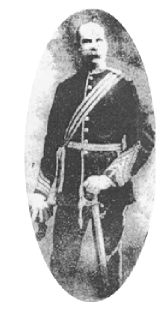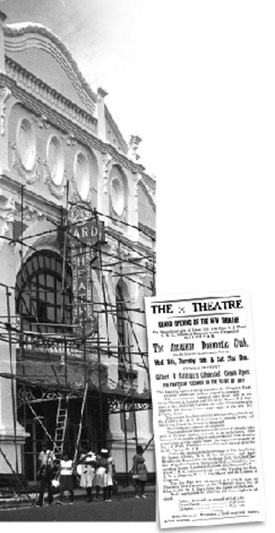|
Ward
Theatre - 1912
STANDING
MAJESTICALLY in North Parade, painted a cool powder blue that beckons
the
 |
eye
no matter the angle of
approach, the Ward Theatre is a national icon. A testament to Jamaican
architecture and philanthropy, the Theatre was a gift of Colonel C. J.
Ward , C.M.G.,(right)
to the citizens of Kingston in 1912. Its architect, Mr. Rudolph Henriques,
was a noted artist whose firm Henriques and Sons was awarded the £9000
commission after winning a competition for the best proposed design.
The Theatre's December 1912 opening was attended by hundreds who witnessed
the presentation of, to quote Altamont Da Costa, then a Trustee and Chairman
of the Theatre Committee, "a structure so magnificent in appearance, so
spacious in its proportions, (and) so artistically finished...."
Declared a national monument in January 7, 2000, the Theatre has a long
history encompassing the nation's social, cultural and political lives.
Its productions are markers of social history and it has functioned as
the National Stage for the Festival Movement. The Ward is also where both
the PNP and the JLP were launched on September 18, 1938 and July
8, 1943 respectively.
 |
Located
in the heart of Kingston, the Ward is the only theatre of its kind in
the English-speaking Caribbean. At a price tag of £12,000, it is built
in a classical style, standing 121 feet east to west, occupying 60,000
cubic feet, with a stage area of 2.146 square feet, and seats over 800.
Built at a time when the city of Kingston was recreating itself after
the devastation of the 1907 earthquake and many buildings (commercial
and ecclesiastical) were commissioned abroad e.g. Holy Trinity Cathedral
the Ward speaks to the ingenuity and depth of local talent.
Right
photograph:
Scaffolding surrounds the Ward Theatre, before its opeining in December
1912.
At right, an advertisement in
the Daily Gleaner announcing the
first play to be staged at the
Ward Theatre.
Made of concrete and steel, it is a sturdy triumph of tropical architecture
able to maintain an air of formality while answering the need for practicality
in ventilation and acoustics.
For his part, Colonel
Ward envisioned the space being used for enjoyment and educational purposes.
His generosity saved citizens and the government from a sure quandary
how to reconstruct a theatre without using taxpayers' money. The interior
décor of the Theatre has not changed much in format from its original
look in 1912 the original domed ceiling is there as are the box seats
and fly tower (a design feature that allows sets to be hoisted above the
stage and lowered at will). A portrait of Colonel Ward, commissioned in
1912, hangs in the Theatre foyer.
Article by Rebecca Tortello.
The
Ward Today
Now
run by the Ward Theatre Foundation without an endowment, the Theatre generates
some income from retals to other performing groups - the Pantomine Company,
Roots Theatre, dance troupes, the JCDC for the schools' finals.... It
receives no regular government funding. It is not hard to understand why
the Theatre has deteriorated in lustre. Where murals depicting historical
scenes of Columbus once stood there are now empty walls. The Theatre needs
a new roof, new parking, new blacony chairs, a new curtain, a new air
conditioning system, and a new stage to name a few current challenges.
Interwined with the syndrome of urban decay affecting much of downtown
Kingston, the outside environs of the Ward have also undergone a tremendous
change for the worse. Audience numbers have routinely fallen as people
who live outside of downtown no longer want to travel downtown in the
evening and the people in teh community do not embrace it as their own.
Productions At The Ward Theatre
- The first production,
mounted from December 19 -21, 1912, was of Gilbert and Sullivan's Pirates
of Penzance. It was staged by the Amateur Dramatic Club of Kingston.
The Gleaner advertisement noted that costumes were identical to those
used at London's Savoy and tickets were sold at Times Store 4 shillings
for dress circle and 2 shillings for the gallery.
- During the 1920s
Broadway plays used to travel to Jamaica and when they returned to Broadway
they would be billed as "fresh from a triumphant run in Kingston, Jamaica."
Broadway Players proudly referred to themselves as "late of the Jamaican
Theatre" because it was a feather in their cap. Theatre has a long history
in Jamaica the island's first theatre was built in the 1750s. The
Ward is the third theatre to stand on its present site. The majority
of these earliest productions tended to be Shakespearan performed by
traveling British Troupes as well as local drama groups comprised mainly
of colonials. The two world wars resulted in a lull in the number of
foreign acts and a rise in local productions. Jamaican theatre really
began to come into its own post-World War II and audiences and actors
gradually became more diverse.
- Speaking to the
integrity of the Ward Theatre space, Wycliffe Bennett, noted dramatist,
leader of the National Festival Movement and current Chairman of the
Ward Theatre Foundation who is currently working on a book on theatre
in 20th century Jamaica, stated "until you can say you have acted in
the Ward and filled the space with your presence, you won't have gotten
very far." In addition to the wealth of local talent that has passed
this test E. M. Cupedon, Stanley Morand, Charles Hyatt, Ranny Williams,
Miss Lou, Leonie Forbes, Oliver Samuels, to name a few other entertainers
to grace the Ward Theatre stage include Marion Anderson, Paul Robeson,
Charles Laughton (who played Capt. Bligh in Mutiny on the Bounty) and
Ella Bell Davis.
- Pantomime has been
associated with the Ward for over 60 years. Since 1941 pantomimes have
debuted at the Ward beginning at 6 p.m. sharp on Boxing Day, with the
exception of one year in the 1950s when the KSAC leased the space to
some other company sparking much outrage. One could say the Pantomime
has now become synonymous with the Ward. Pantomime can be defined as
an English theatre convention that takes tales of childhood and dramatize
through song. According to one of its longest participants, Barbara
Gloudon, "we made it our own adding our music, speech and stories
that often reflect social commentary." Today Jamaican Pantomime is achieving
recognition in books on theatre around the world living testimony
to the creative spirit of the Jamaican people.
|
| Feedback
To the Series |
|
"I have
found your articles on the Pieces of the Past most entertaining
and interesting to read. For me as a historian these pieces come
at a time when Jamaicans need to reconnect themselves with their
past and the Gleaner's efforts through this medium is quite commendable.
I have found
especially today's article on the 1780 hurricane to be quite of
interest to me as I am currently involved in bringing to light the
role of natural disasters in the development of Jamaica's history,
culture, society, economy and politics and the article on the "Hurricane
of 1780" has greatly aided in this direction. Keep up the good
work and I look forward to more interesting and historically significant
pieces from this series." - Kerry-Ann
|
| The
First 500 years in Jamaica |
|
We're
taking you for a stroll down memory lane for the next six
months. Along this journey,we will relive several events which
significantly impacted on the social, political and economic
development of Jamaica. As we travel share your experience
with us...
Send your comments to:
Pieces
of the Past,
The Gleaner Company Ltd.,
7 North Street, Kingston;
E - mail us: editor@gleanerjm.com
Fax 922-6223.
|
|
|



